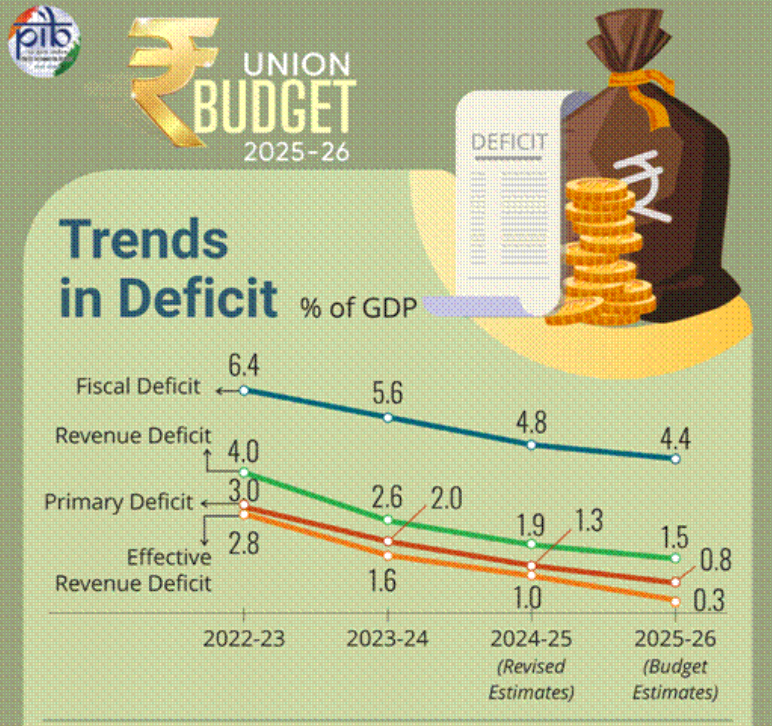CAG Review of the FRBM Act | 22 Aug 2025
Why in News?
The Comptroller and Auditor General (CAG) presented its 2023-24 annual review of the Fiscal Responsibility and Budget Management (FRBM) Act, 2003, in Parliament.
- The review shows that India is moving steadily towards long-term macroeconomic stability.
What are the Key Highlights of the CAG Review of the FRBM Act for FY 2023-24?
- Central Government Debt: Declined to 57% of Gross Domestic Product (GDP) (March 2024) from 61.38% in FY 2020-21.
- General Government Debt (GGD): GGD declined slightly from 83% of GDP in March 2022 to 81.3% in March 2023, still far above the 60% target.
- Debt Sustainability Analysis (DSA): DSA assesses the government’s ability to service debt, with the debt-to-GDP ratio as the key measure.
- A sustainable fiscal policy is one where the debt-to-GDP ratio is stable or declining over the long term.
- The Centre’s debt-to-GDP ratio peaked at 61.38% in FY 2020-21 and declined to 57% in FY 2023-24.
- Unrealised Taxes: At the end of FY 2023-24, Rs 31.11 lakh crore in taxes remained unrealised, up Rs 9.81 lakh crore from the 2022-23.
What is Fiscal Responsibility and Budget Management (FRBM) Act, 2003?
- About: The FRBM Act, 2003 was enacted to reduce fiscal deficits and promote long-term macroeconomic stability and inter-generational equity.
- It has since been amended in 2004, 2012, 2015, and 2018 to revise deficit targets, set new debt reduction goals, and allow flexibility in fiscal management during crises or economic uncertainties.
- Key Provisions:
- Fiscal Responsibility: The Act mandates that the Finance Minister review fiscal trends and present half-yearly reviews to both Houses of Parliament.
- Medium-Term Fiscal Policy (MTFP): The Act mandates the presentation of the MTFP statement, which outlines three-year rolling targets for key fiscal indicators like Revenue Deficit, Fiscal Deficit, and Central Government Debt as a percentage of GDP.
- Implementation: The CAG conducts annual reviews to assess the government's compliance with the FRBM targets.
- FRBM Targets: The 2018 amendment set targets to reduce General Government Debt (Centre + States, excluding inter- governmental liabilities) to 60% of GDP and Central Government Debt to 40% by FY 2024-25.
- The Fiscal Deficit(FD) target is 3% of GDP by March 2021(target deferred due to pandemic). The government now commits to FD below 4.5% of GDP by 2025-26.
- In June 2025, the Government of India successfully met its fiscal deficit target of 4.8% of GDP for FY 2024–25.
- The government shall not provide additional loan guarantees on the security of the Consolidated Fund of India in excess of one-half per cent of GDP in any financial year.
- The Fiscal Deficit(FD) target is 3% of GDP by March 2021(target deferred due to pandemic). The government now commits to FD below 4.5% of GDP by 2025-26.
| Read More: India's Fiscal Consolidation, Government's Long-Term Fiscal Discipline |
UPSC Civil Services Examination, Previous Year Questions (PYQs)
Prelims:
Q. Consider the following statements: (2018)
- The Fiscal Responsibility and Budget Management (FRBM) Review Committee Report has recommended a debt to GDP ratio of 60% for the general (combined) government by 2023, comprising 40% for the Central Government and 20% for the State Governments.
- The Central Government has domestic liabilities of 21% of GDP as compared to that of 49% of GDP of the State Governments.
- As per the Constitution of India, it is mandatory for a State to take the Central Government’s consent for raising any loan if the former owes any outstanding liabilities to the latter.
Which of the statements given above is/are correct?
(a) 1 only
(b) 2 and 3 only
(c) 1 and 3 only
(d) 1, 2 and 3
Ans: C
Q. A country's fiscal deficit stands at 50,000 crores. It is receiving 10,000 crores through non-debt creating capital receipts. The country's interest liabilities are 1,500 crores. What is the gross primary deficit? (2025)
(a) 48,500 crores
(b) 51,500 crores
(c) 58,500 crores
(d) None of the above
Ans: (a)

